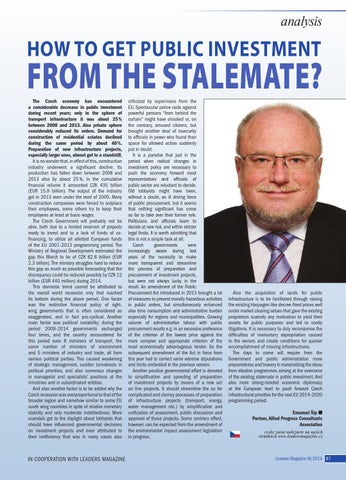analysis
HOW TO GET PUBLIC INVESTMENT
FROM THE STALEMATE? The Czech economy has encountered a considerable decrease in public investment during recent years; only in the sphere of transport infrastructure it was about 25 % between 2008 and 2013. Also private sphere considerably reduced its orders. Demand for construction of residential estates declined during the same period by about 40 %. Preparation of new infrastructure projects, especially larger ones, almost got to a standstill. It is no wonder that, in effect of this, construction industry underwent a significant decline. Its production has fallen down between 2008 and 2013 also by about 25 %, in the cumulative financial volume it amounted CZK 435 billion (EUR 15.9 billion). The output of the industry got in 2013 even under the level of 2005. Many construction companies were forced to outplace their employees, some others try to keep their employees at least at basic wages. The Czech Government will probably not be able, both due to a limited reservoir of projects ready to invest and to a lack of funds of cofinancing, to utilize all allotted European funds of the EU 2007–2013 programming period. The Ministry of Regional Development estimated the gap this March to be of CZK 62.8 billion (EUR 2.3 billion). The ministry struggles hard to reduce this gap as much as possible forecasting that the discrepancy could be reduced possibly by CZK 12 billion (EUR 440 million) during 2014. This domestic trend cannot be attributed to the overall world recession only that reached its bottom during the above period. One factor was the restrictive financial policy of rightwing governments that is often considered as exaggerated, and in fact pro-cyclical. Another main factor was political instability; during the period 2009–2014 governments exchanged four times, and the country encountered for this period even 8 ministers of transport, the same number of ministers of environment and 5 ministers of industry and trade, all from various political parties. This caused weakening of strategic management, sudden turnabouts in political priorities, and also numerous changes in managerial and specialists’ positions at the ministries and in subordinated entities. And also another factor is to be added why the Czech recession was overproportional to that of the broader region and somehow similar to some EU south wing countries in spite of relative monetary stability and only moderate indebtedness. More scandals got to the daylight about lobbyists that should have influenced governmental decisions on investment projects and even attributed to their inefficiency that was in many cases also
IN COOPERATION WITH LEADERS MAGAZINE
criticized by supervisors from the EU. Spectacular police raids against powerful persons “from behind the curtain” might have shocked or, on the contrary, amused citizens, but brought another deal of insecurity to officials in power who found their space for allowed action suddenly put in doubt. It is a paradox that just in the period when radical changes in investment policy are necessary to push the economy forward most representatives and officials of public sector are reluctant to decide. Old lobbyists might have been, without a doubt, an ill driving force of public procurement, but it seems that nothing significant has come so far to take over their former role. Politicians and officials learn to decide at new risk, and within stricter legal limits. It is worth admitting that this is not a simple task at all. Czech governments were increasingly aware during last years of the necessity to make more transparent and streamline the process of preparation and procurement of investment projects, but were not always lucky in the result. An amendment of the Public Procurement Act introduced in 2013 brought a lot of measures to prevent morally hazardous activities in public orders, but simultaneously enhanced also time consumption and administrative burden especially for regions and municipalities. Growing volume of administrative labour with public procurement results e.g. in an excessive preference of the criterion of the lowest price against the more complex and appropriate criterion of the most economically advantageous tender. So the subsequent amendment of the Act in force from this year had to correct some extreme stipulations and limits embodied in the previous version. Another positive governmental effort is devoted to simplification and speeding of preparation of investment projects by means of a new act on line projects. It should streamline the so far complicated and clumsy processes of preparation of infrastructure projects (transport, energy, water management etc.) by simplification and unification of assessment, public discussion and approval of those projects. Some contrary effect, however, can be expected from the amendment of the environmental impact assessment legislation in progress.
Also the acquisition of lands for public infrastructure is to be facilitated through raising the existing Harpagon-like decree-fixed prices well under market clearing values that gave the existing proprietors scarcely any motivation to yield their assets for public purposes and led to costly litigations. It is necessary to duly recompense the difficulties of involuntary expropriation caused to the owners and create conditions for quicker accomplishment of missing infrastructures. The days to come will require from the Government and public administration more preparedness and bravery in materializing the ideas from election programmes aiming at the overcome of the existing stalemate in public investment. And also more strong-minded economic diplomacy at the European level to push forward Czech infrastructural priorities for the next EU 2014–2020 programming period. Emanuel Šíp ■ Partner, Allied Progress Consultants Association české znění naleznete na našich stránkách www.leadersmagazine.cz
Leaders Magazine III/2014 87
